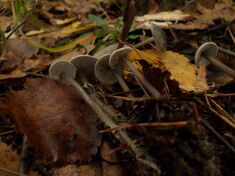Biology:Tephrocybe rancida
| Tephrocybe rancida | |
|---|---|

| |
| Scientific classification | |
| Kingdom: | |
| Division: | |
| Class: | |
| Order: | |
| Family: | |
| Genus: | |
| Species: | T. rancida
|
| Binomial name | |
| Tephrocybe rancida (Fr.) Donk 1962
| |
| Synonyms[1][2] | |
|
Agaricus rancidus Fr. 1821 | |
| Tephrocybe rancida | |
|---|---|
| Mycological characteristics | |
| gills on hymenium | |
| cap is convex or flat | |
| hymenium is free | |
| stipe is bare | |
| spore print is white | |
| ecology is saprotrophic | |
| edibility: unknown | |
Tephrocybe rancida is a species of fungus in the family Lyophyllaceae. It was first described by Swedish mycologist Elias Magnus Fries in 1821. It is commonly called the Rancid Greyling due it's rancid smell and taste.
Description
Cap 1–4 cm in diameter. Convex to flat, umbonate. Grey to brown-grey starting with a whitish bloom. Shiny when wet. Gills Free, crowded, grey. Stem 4–8 cm long by 3–7 mm in diameter, concolorous with cap. Spores white or cream, ellipsoid, 7–8 × 3–4.5 m.
Distribution and habitat
Found growing from the ground, solitary in deciduous woodland. Early autumn to early winter. Rare. North America and Europe.
References
- ↑ "Tephrocybe rancida (Fr.) Donk 1962". Encyclopedia of Life. http://www.eol.org/pages/1015716.
- ↑ "Tephrocybe rancida (Fr.) Donk 1962". MycoBank. http://www.mycobank.org/MycoTaxo.aspx?Link=T&Rec=339961.
External links
Wikidata ☰ Q3914315 entry
 |

